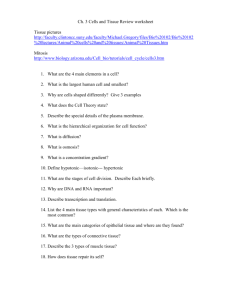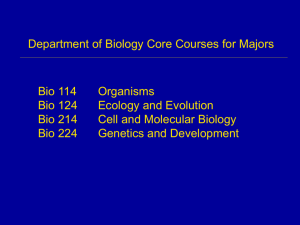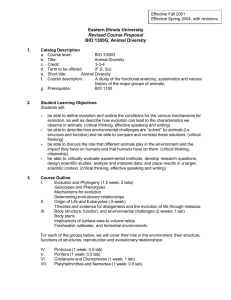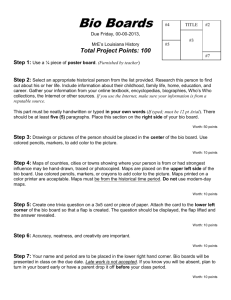New/Special Course Proposal-Bulletin Change Transmittal Form
advertisement
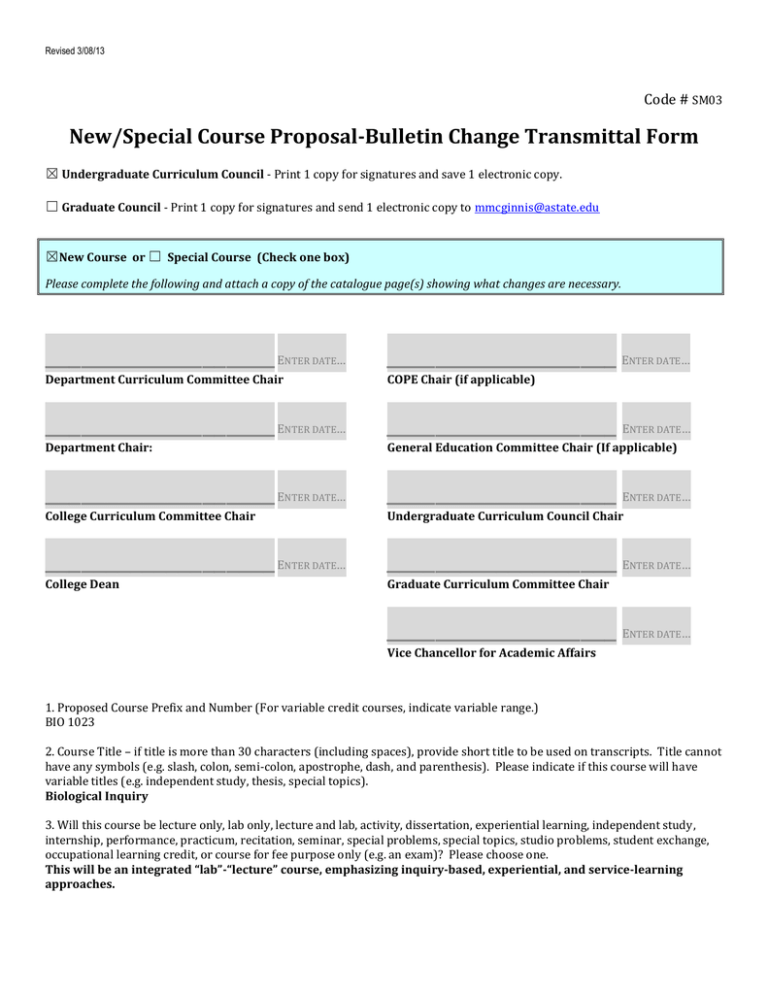
Revised 3/08/13 Code # SM03 New/Special Course Proposal-Bulletin Change Transmittal Form ☒ Undergraduate Curriculum Council - Print 1 copy for signatures and save 1 electronic copy. ☐ Graduate Council - Print 1 copy for signatures and send 1 electronic copy to mmcginnis@astate.edu ☒New Course or ☐ Special Course (Check one box) Please complete the following and attach a copy of the catalogue page(s) showing what changes are necessary. ___________________ ENTER DATE… ___________________ ENTER DATE… ___________________ ENTER DATE… ___________________ ENTER DATE… Department Curriculum Committee Chair Department Chair: ENTER DATE… ___________________ ENTER DATE… ___________________ ENTER DATE… ___________________ ENTER DATE… COPE Chair (if applicable) General Education Committee Chair (If applicable) College Curriculum Committee Chair College Dean ___________________ Undergraduate Curriculum Council Chair Graduate Curriculum Committee Chair ___________________ ENTER DATE… Vice Chancellor for Academic Affairs 1. Proposed Course Prefix and Number (For variable credit courses, indicate variable range.) BIO 1023 2. Course Title – if title is more than 30 characters (including spaces), provide short title to be used on transcripts. Title cannot have any symbols (e.g. slash, colon, semi-colon, apostrophe, dash, and parenthesis). Please indicate if this course will have variable titles (e.g. independent study, thesis, special topics). Biological Inquiry 3. Will this course be lecture only, lab only, lecture and lab, activity, dissertation, experiential learning, independent study, internship, performance, practicum, recitation, seminar, special problems, special topics, studio problems, student exchange, occupational learning credit, or course for fee purpose only (e.g. an exam)? Please choose one. This will be an integrated “lab”-“lecture” course, emphasizing inquiry-based, experiential, and service-learning approaches. Revised 3/08/13 4. What is the grade type (i.e. standard letter, credit/no credit, pass/fail, no grade, developmental)? Standard Letter 5. Is this course dual listed (undergraduate/graduate)? no 6. Is this course cross listed? (If it is, all course entries must be identical including course descriptions. It is important to check the course description of an existing course when adding a new cross listed course.) no 7. Brief course description (40 words or fewer) as it should appear in the bulletin. An inquiry-based introduction to concepts in biology, with an emphasis on behavior, ecology, and evolution. Researchoriented activities will emphasize the skills and attitudes necessary for understanding and conducting scientific inquiry. 8. Indicate all prerequisites and if this course is restricted to a specific major, which major. (If a student does not have the prerequisites or does not have the appropriate major, the student will not be allowed to register). a. Are there any prerequisites? Permission of Instructor b. Why? This is an introductory course intended to prepare students for the introductory zoology-botany sequence. Incoming students will be placed into this course according to their background and ACT scores. 9. Course frequency (e.g. Fall, Spring, Summer). Not applicable to Graduate courses. Fall 10. Contact Person (Name, Email Address, Phone Number) Dr. Paul Sikkel, Department of Biological Sciences, LSE 412, psikkel@astate.edu, 972-3296 11. Proposed Starting Term/Year Fall 2014 12. Is this course in support of a new program? Yes/No If yes, what program? No 13. Does this course replace a course being deleted? Yes/No If yes, what course? No Has this course number been used in the past? No Submit Course Deletion Proposal-Bulletin Change Transmittal Form. 14. Does this course affect another program? No If yes, provide contact information from the Dean, Department Head, and/or Program Director whose area this affects. Enter text... 15. Justification should include: a. Academic rationale and goals for the course (skills or level of knowledge students can be expected to attain) The development of this course is driven by an internal assessment of performance of our students in the introductory Zoology-Botany sequence. This course “closes the loop” by serving and helping to retain students who enter ASU with an interest in the biological sciences but who are inadequately prepared for the first-year Zoology-Botany sequence. Given that Revised 3/08/13 evolution is the cornerstone of the biological sciences, the content- focus is on key evolutionary concepts. The course utilizes an inquiry-based format which requires critical, independent thinking, development of research skills, writing skills, presentation skills, and service learning. b. How does the course fit with the mission established by the department for the curriculum? If course is mandated by an accrediting or certifying agency, include the directive. The mission of the Department of Biological Sciences is to expose students to the excitement of biological inquiry, retain them in a program of study, provide them with career guidance, equip them with the background and training necessary for their chosen career path, and enable and expect them to think broadly and critically about the biological world that surrounds them. This course is designed to support all of these components, but especially the first two. c. Student population served. This course will serve first-year undergraduate students in the biological sciences who have been assessed to have inadequate preparation for the introductory Zoology-Botany sequence d. Rationale for the level of the course (lower, upper, or graduate). This is an introductory-level course for first-year students. 16. Outline (The course outline should be topical by weeks and should be sufficient in detail to allow for judgment of the content of the course.) Week 1 – History of Biology, levels of Biological inquiry Week 2&3 – The nature of scientific inquiry Week 4-6 -- Evolutionary concepts Week 7-10 -- Animal Behavior as a way of understanding integrative biology and adaptation Week 10-12 -- Making sense of biodiversity Week 13 & 14 – Service learning projects 17. Course requirements (e.g. research papers, projects, interviews, tests, etc.) Grading is based on a variety of activities that are categorized as: 31% Scientific content (Tests, Peer-assessment, and Final Exam ) 37% Scientific presentation (Essays, Draft and Final Papers/Poster, Seminar Reports- 130 pts.) 32% Assignments (e.g., literature searches, group projects, computer simulations, service learning project). Cooperative learning strategies will be used to help students learn to work together in order to maximize their own and each other's learning. Success in cooperating as a research team will also be evaluated throughout the course. On some assignments, group grades may be part of the individual grade. Criteria for earning group points will be explained as students conduct the team activities. Points for some assignments will be based on rubrics. Students will work extensively in the laboratory and field. In addition, all students are required to attend a minimum of two research seminars. Only approved seminars are acceptable. For each seminar, students must provide the instructor with a one page typed summary in which they 1) state the purpose of the research conducted, 2) give a brief explanation the scientific methods used, 3) state the conclusions resulting from the research, and 4) give their impression of the quality of the presentation (i.e., explain what you thought was well presented and what was not well presented). 18. Special features (e.g. labs, exhibits, site visitations, etc.) Field excursions may be incorporated and use of computers will be required during class meetings. 19. Department staffing and classroom/lab resources (Will this require additional faculty, supplies, etc.?) Each section of this course will require a team of 3 instructors: A lead instructor, and two assistants. 20. What is the primary intended learning goal for students enrolled in this course? The successful student will develop the skills and attitudes necessary for understanding and conducting scientific inquiry Revised 3/08/13 21. Reading and writing requirements: a. Name of book, author, edition, company and year McMillan, V.E. 2012. A Student Handbook for Writing in Biology. 5th. edition. Sinauer Associates, Inc. and W. H. Freeman and Co. Wilson, E.O. 2010. The Diversity of Life. Harvard University Press Bowen, D. D., and Jackson, C. N. (1985-6). "Curing those 'ol 'Omigod-Not-Another-Group-Class' blues". Organizational Behavior Teaching Review, 10(4), 21-23. http://www.wcer.wisc.edu/archive/cl1/CL/doingcl/hints.htm. Other readings as assigned for each module. A course manual will be developed b. Number of pages of reading required per week: 40 c. Number of pages of writing required over the course of the semester: 30 22. High-Impact Activities (Check all that apply) ☒ Collaborative assignments ☐ Research with a faculty member ☒ Diversity/Global learning experience ☒ Service learning or community learning ☐ Study abroad ☐ Internship ☐ Capstone or senior culminating experience ☐ Other Explain: Enter text... 23. Considering the indicated primary goal (in Box #20), provide up to three outcomes that you expect of students after completion of this course. Outcome #1: (For example, what will students who meet this goal know or be able to do as a result of this course?) The successful student will understand key evolutionary concepts Learning Activity: (For example, what instructional processes do you plan to use to help students reach this outcome?) Knowledge of key concepts will be initially assessed during a pretest. These concepts will then be reinforced during each of the course modules and through all course activities (e.g., group presentations, individual reading and writing assignments, computer simulations). Assessment Tool: (For example, what will students demonstrate, represent, or produce to provide evidence of their learning?) Embedded questions - Embedded questions will be included on each exam to assess understanding of key concepts. Students would be told that some questions are for assessment purposes only and do not count toward the grade, but they should answer all questions. These questions would be “flagged” and scored separately. Mastery of these concepts will further be assessed during final student presentations in which students will be required to properly incorporate these concepts. (Repeat if needed for additional outcomes 2 and 3) Outcome #2: Critical thinking Learning Activity: Revised 3/08/13 As part of individual writing assignments, group activities, and computer simulation exercises, students will be presented with real or imagined observations and scenarios and asked to derive a list of potential explanations (hypotheses) and how they would test them. Assessment Tool: Answers to a real-world analog will be evaluated according to a departmentally designed rubric that models our CAT critical thinking assessment tool. Outcome #3: Presentation skills Learning Activity: Students will be required to present results of problem sets and computer simulations to demonstrate their understanding of basic concepts covered in each module. These will include at least 3 short (10-15 min) and one longer (20-30 min) presentations. Assessment Tool: Presentations are required in most of the course proposers (Sikkel) courses and he has developed rubrics for these presentations. Presentations are evaluated by both the instructors and students. 24. Please indicate the extent to which this course addresses university-level student learning outcomes: a. Global Awareness ☐ Minimally ☐ Indirectly ☒ Directly b. Thinking Critically ☐ Minimally ☐ Indirectly ☒ Directly c. Using Technology ☐ Minimally ☒ Indirectly ☒ Directly From the most current electronic version of the bulletin, copy all bulletin pages that this proposal affects and paste it to the end of this proposal. To copy from the bulletin: 1. 2. 3. 4. 5. Minimize this form. Go to http://registrar.astate.edu/bulletin.htm and choose either undergraduate or graduate. This will take you to a list of the bulletins by year, please open the most current bulletin. Find the page(s) you wish to copy, click on the “select” button and highlight the pages you want to copy. Right-click on the highlighted area. Revised 3/08/13 6. 7. 8. 9. 10. Click on “copy”. Minimize the bulletin and maximize this page. Right-click immediately below this area and choose “paste”. For additions to the bulletin, please change font color and make the font size larger than the surrounding text. Make it noticeable. For deletions, strike through the text, change the font color, and enlarge the font size. Make it noticeable. Biology (BIO) BIO 1013. Making Connections Biology Required course for first semester freshmen. Core content includes transition to college, academic performance skills, problem solving, critical thinking, self management, group building skills, and university policies. Content related to the departmental majors is also included. Fall. An inquiry-based introduction to concepts in biology, with an emphasis on behavior, ecology, and evolution. Research-oriented activities will emphasize the skills and attitudes necessary for understanding and conducting scientific inquiry. Fall. Permission of Instructor. BIO 1023 Biology Inquiry BIO 1201. Human Anatomy Laboratory Study of the structure of the human body with emphasis on the muscular, skeletal, nervous, and vascular systems. For Radiologic Technology Science majors only. Special course fees may apply. Two hours per week. It is recommended this course be taken concurrently with BIO 1203. Fall. BIO 1203. Human Anatomy Study of the structure of the human body with emphasis on the muscular, skeletal, nervous, and vascular systems. For Radiologic Technology Science majors only. Three hours per week. Special course fees may apply. It is recommended this course be taken concurrently with BIO 1201. Fall. BIO 1211. Human Physiology Laboratory Study of the function of the human body with emphasis on the muscular, skeletal, nervous, respiratory and vascular systems. For Clinical Laboratory Science associate degree majors only. Two hours per week. Special course fees may apply. To be taken concurrently with BIO 1213. Spring. BIO 1213. Human Physiology Study of the function of the human body with emphasis on the muscular, skeletal, nervous, respiratory and vascular systems. For Clinical Laboratory Science associate degree majors only. Three hours per week. Special course fees may apply. It is recommended that this course be taken concurrently with BIO 1211. Spring. BIO 1301. Biology of Animals Laboratory Two hours per week. Special course fees may apply. It is recommended this lab be taken concurrently with BIO 1303. Fall, Spring, Summer, even. (ACTS#: BIO 1054) BIO 1303. Biology of Animals Fundamentals of modern zoology and a survey of the phyla. Lecture three hours per week. Special course fees may apply. Fall, Spring, Summer, even. (ACTS#: BIOL 1054) BIO 1501. Biology of Plants Laboratory Three hours per week. It is recommended that this lab be taken concurrently with BIO 1503. Special course fees may apply. Fall, Spring, Summer, odd. (ACTS#: BIOL 1034) BIO 1503. Biology of Plants Form, structure, function, and reproduction of plants. Lecture three hours per week. Special course fees may apply. Fall, Spring, Summer, odd. (ACTS#: BIOL 1034) BIO 2011. Biology of the Cell Laboratory Two hours per week. Recommended to be taken concurrently with BIO 2013. Special course fees may apply. Prerequisite, CHEM 1011. BIO 2013. Biology of the Cell An introduction to structures and processes in cells, including cellular evolution, biologically important molecules, organelle structure and function, and cellular energy. Lecture three hours per week. Special course fees may apply. Prerequisite, CHEM 1013. Fall, Spring.
